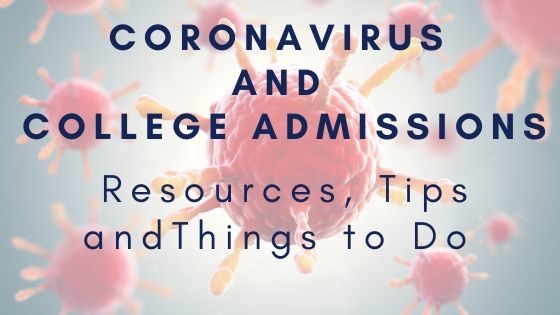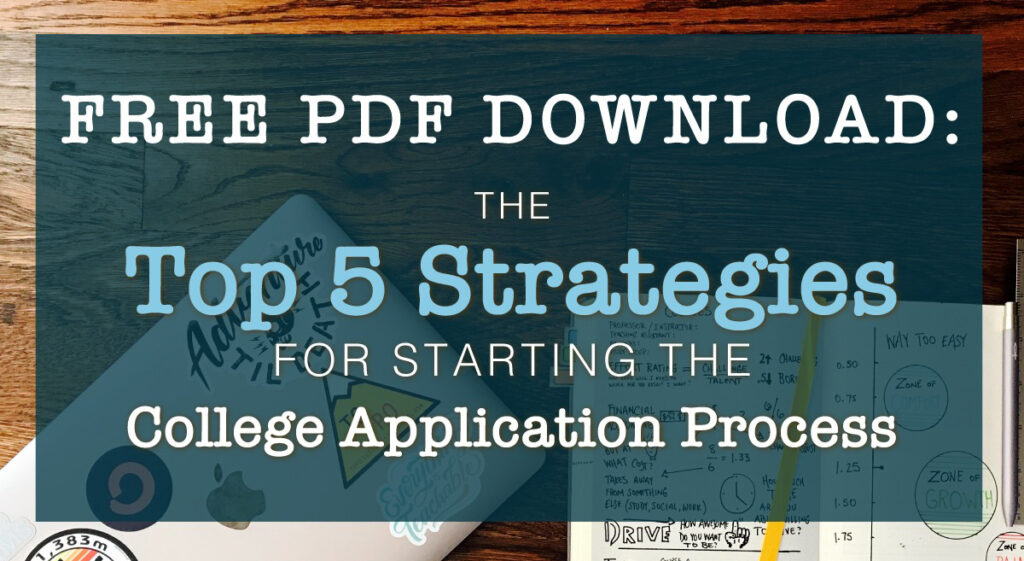Have you ever forgotten something? How to do something on a test? A password? The time of your doctor’s appointment?
Well, it happens. I had a student mention an interesting research project he did AFTER he was deferred from his early decision school. He “forgot” about it, and it didn’t make it into his applications.
Luckily, this story has a happy ending. The student emailed the college and “elaborated” on his summer experience. He is now a graduate of Pomona College.
So, things worked out, but it made me wonder… How can I make sure this doesn’t happen again?
Now when I work with a student, whether it be one-on-one or through an online course, I make sure they are aware of the steps for a complete application strategy. Let’s go through each step of developing a college application strategy so that you can put your best foot forward!
Step 1: Know your Opportunities
Identify all of the opportunities you have to present yourself in college applications.
-
- Transcript and School Profile
- Standardized Testing (if required)
- Teacher Recommendations
- School Counselor Recommendation
- Personal Recommendations
- Activities or Resume
- Personal Statement/College Essay/Common App Essay
- Supplemental essays
- COVID-19 Optional Essay
- Additional Information Section
- Interviews or Demonstrating Interest
Let’s break down each piece of the college application.
Your high school transcript is the most important piece of your college application. It reflects your academic abilities, work ethic, and more. However, colleges are looking at more than your GPA and class rank (if available). When reviewing your transcript, colleges will also consider the challenge of your curriculum or the number of AP, IB, College Level, or Honors courses you took based on what is available to you. Colleges will know how many challenging courses are available to you through your high school profile, including information regarding your high school’s academic environment.
Colleges will use the information provided in your teacher recommendations to complete their analysis of your academic profile. . You must identify and build relationships with teachers who can speak to your intellectual curiosity and your performance in the classroom beyond completing assignments promptly.
The use and analysis of standardized testing scores vary significantly in the world of college admission. Most colleges will report their SAT or ACT scores as the “middle 50%,” meaning if their average ACT score is 25 to 32, 25% of admitted students scored below a 25, and 25% scored above a 32. However, if you are applying test-optional, a college may place more emphasis on your transcript. This is also true if a college decides they are no longer considering test scores in their process (test-blind or test-free).
Most colleges will require a letter of recommendation from your school counselor to understand how you have contributed to your high school community. Your counselor may also ask you to complete a questionnaire about your interests, achievements, etc. You can also submit an additional letter of recommendation from someone in your high school or community (e.g., a coach, club advisor, clergy member, supervisor, etc.).
For your activities, admissions officers are looking for students who are committed to their interests. They used to want to see “well-rounded” students who participated in everything. Now they want to see students who have focused on one or two interests and pursued those interests on a deeper level. This is an excellent place to show colleges how you have contributed to your high school or local community.
Your essay is perhaps the piece of your application where you have the most control. It allows colleges to see a side of you that may not come through on your transcript or in your letters of recommendation. Many students feel that the personal statement has to be “different” to stand out, but it is more important that it’s well-written. Take the time to examine something personal to you, something you are passionate about, to truly create a well-written piece.
Many colleges require supplemental essays, which are often shorter than your main personal statement and are your opportunity to show a college why you are interested in attending. The supplemental essays can also be an opportunity to demonstrate your creativity or academic interests.
Currently, most colleges have a place in your application to provide information about how COVID-19 affected you or your family. This is an opportunity for you to provide the context of any COVID-19 related challenges you have faced.
Similar to the COVID-19 prompt, the additional information section is where you can provide context regarding any other issues or challenges. This section is often used to explain low grades or why you did not continue to participate in a sport.
While most colleges may not admit it, they want to accept students they think will enroll at their school. While some colleges do not consider demonstrated interest, many do. You can show colleges you are interested by contacting the admissions officer responsible for reviewing applications for your area. If you cannot visit the college, you can sign up for virtual presentations and campus tours online. Completing admissions interviews (if offered) is another way to show colleges you are a real human being.
Step 2: List the Details
Brainstorm EVERYTHING you want to include in your applications. This list can include, but is not limited to:
-
- Accolades from coaches, mentors, or teachers
- Activities
- Research interests
- Career interests
- Personal characteristics
- Values and beliefs
- Interesting experiences
- Job shadowing or internship experiences
- Academic interests
- Anything you can do for hours
- Challenges or hardships
- How you’ve contributed to your high or local community
- Family responsibilities
- Goals, dreams, and aspirations
- What’s important to you
- What legacy will you leave behind at your high school
-
Step 3: Plan
- Finally, identify where the details will be in your college applications and develop a strategy. I encourage students to map out the details of all of the other application pieces before the essay. For example, identify which personal characteristics will be highlighted in your teacher recommendations. Go through each item on the list and determine where it will be on your application. Is there one you can’t place? That should probably be the topic of your essay.
This year, the details of your college applications are more critical than ever. Many students may not have an ACT or an SAT score. Others are unhappy with their junior year grades since most of last year was hybrid or online. Showcasing all the other details about YOU in your college applications will show colleges how amazing you are, even if you don’t have all of the “normal” application pieces.











